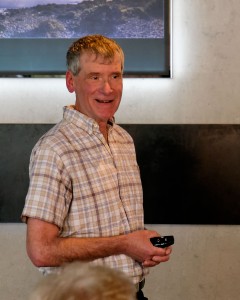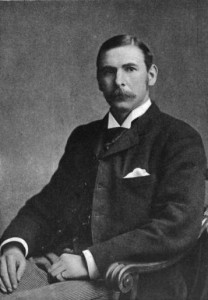April 28, 2015
William Christie and the Demise of the Royal Greenwich Observatory – History of Astronomy Group Meeting
Graham Dolan
Report by: Mike Dryland
Graham was formerly Senior Education Officer at the ROG. Since his retirement he has devoted a great deal of time to researching the history of the Observatory and developing his excellent Royal Observatory and Greenwich Meridian websites. He has organised and posted a large amount of little-known material about the people at the ROG and the development of the sites and equipment not only at Greenwich but also its out-stations and later the RGO at Herstmonceux.
Graham spoke about the eighth Astronomer Royal, Sir William H. M. Christie 1845-1922 (AR 1881-1910). Graham’s talk was detailed and copiously illustrated with images many of which have seldom been seen before.
He charted Christie’s early life and career. Christie was pretty much Royal Observatory ‘man and boy’ – within about a year of graduating Wrangler from Trinity (1868) he became Chief Assistant to the AR George Airy, and succeeded Airy in 1881 on his retirement.
Graham looked in some detail at the development of the ROG Greenwich site under Christie. Much of what we now see at Greenwich is the legacy of Christie and Airy before him. In particular Christie was responsible for the construction of the South Building (originally known as the New Physical Observatory) now the Astronomy Centre. Christie could also claim the building of the Altazimuth Pavilion originally with a new altazimuth instrument, and the acquisition of four major equatorial telescopes – the Lassell, the 28-in Great Equatorial, and the two Thompsons. The Lassell was dismantled in the 1890s and most is now lost. The 28-in Great Equatorial can be seen in situ at Greenwich, and the Thompsons can be seen at Herstmonceux.
During Christie’s time the Observatory assumed a leading role in the international Carte du Ciel project to prepare a photographic star chart of the entire sky. Greenwich acquired one of the 13-in Astrographic telescopes from Grubb of Dublin. This was mounted in a dome on the roof of the Meridian Observatory. The Astrograph can now be seen at Herstmonceux. It was also in Christie’s time that Greenwich began to gain official recognition as the International Prime Meridian, zero degrees longitude (1884), although this was thanks to the accumulated work since Flamsteed and especially Maskelyne and Airy.
The growth of magnetic observing work and interference from large metal equipment being installed, provoked Christie to acquire a new site in Greenwich Park known as the Christie Enclosure (1897). Later the Enclosure became home to the Yapp Reflector (1932) now at Herstmonceux. When the RGO moved out of Greenwich the Enclosure was returned to the Park.
While recognising Christie’s accomplishments and legacy, the main thrust of Graham’s talk was to argue that Christie set the ROG (later RGO) firmly on the path to eventual extinction. Graham’s case was that it was Christie’s reluctance to seek a better site away from Greenwich which started the rot.
Even though the problems of observing at Greenwich had been obvious and growing since the 1870s, not only was Christie loath to leave but, starting with the Lassell, he significantly increased investment in the Greenwich site and added land to it. The wishes of Henry Thompson when he donated the new telescopes added to Christie’s entrenchment at Greenwich. This was happening at a time when major observatories, especially in the New World, were heading out of town and indeed establishing mountain sites. By the time that the problems of the Greenwich location could no longer be ignored, the World Wars and related austerity intervened and made the move out far more difficult. Graham argued that in Christie’s time a rather compliant Board of Visitors and changing staffing policies also bolstered complacency and created trouble for the future.
After 1945, austerity, delays, intervention from officialdom, and the bungling of the succession to AR distracted the RGO. It became obvious that the future of visual observing was overseas, and after the RGO’s focus on moving the Isaac Newton, and designing the Anglo-Australian and William Herschel telescopes, its role became unclear and unwanted.
Graham’s talk was a fascinating in-depth view of Christie’s time and included many images not previously seen by the attentive audience. His arguments about Christie’s role in the demise of the RGO were intriguing although raised as many questions as they answered.
Mike Dryland
Reproduced below, with thanks to Graham, is his page of notes and links offered to support the talk. Interested readers are referred to Graham’s website for a veritable encyclopaedia of further information.
People: William Christie, Astronomer Royal
This page covers Christie’s life and many of the changes that took place on his watch. There are links to the telescopes and buildings connected with him etc.
Abinger Magnetic Observatory (1923-1957)
This page covers in detail the whole story and background to the magnetic of the interference at Greenwich caused by the railways.
Deteriorating conditions at Greenwich and the selection of the new location for the Observatory
The buildings and grounds at Herstmonceux
People, politics and changing priorities
These three pages are essential reading for understanding the politics and difficulties that arose during the Observatory’s Herstmonceux years.
This page gives details of how the Board was constituted and how it operated.
A guide to grading and staffing structures
This page gives details of how staffing structures changed over the years.
The International Meridian Conference
This page gives details of the build up to the conference and how its resolutions were put into practice.
Longitude determinations (1888–1902)
This link takes you to the volume of results and discussions of the Greenwich – Paris longituded determinations that were carried out in 1888, 1892 and 1902.
Stables, workshops, sheds and other miscellaneous buildings
This page has woodcuts derived from the photos of the Transit of Venus huts on the South Ground. Note the Victorian equivalent of ‘photoshopping’ that was carried out on the second one.
Graham Dolan 4/2015
Pictures from the Evening (by Mike Meynell):
Posted under: Flamsteed, History of Astronomy, Meeting Report






You must be logged in to post a comment.